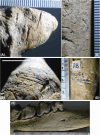Hominin presence in Eurasia by at least 1.95 million years ago
- PMID: 39833162
- PMCID: PMC11747263
- DOI: 10.1038/s41467-025-56154-9
Hominin presence in Eurasia by at least 1.95 million years ago
Abstract
The timing of the initial dispersal of hominins into Eurasia is unclear. Current evidence indicates hominins were present at Dmanisi, Georgia by 1.8 million years ago (Ma), but other ephemeral traces of hominins across Eurasia predate Dmanisi. However, no hominin remains have been definitively described from Europe until ~1.4 Ma. Here we present evidence of hominin activity at the site of Grăunceanu, Romania in the form of multiple cut-marked bones. Biostratigraphic and high-resolution U-Pb age estimates suggest Grăunceanu is > 1.95 Ma, making this site one of the best-dated early hominin localities in Europe. Environmental reconstructions based on isotopic analyzes of horse dentition suggest Grăunceanu would have been relatively temperate and seasonal, demonstrating a wide habitat tolerance in even the earliest hominins in Eurasia. Our results, presented along with multiple other lines of evidence, point to a widespread, though perhaps intermittent, presence of hominins across Eurasia by at least 2.0 Ma.
© 2025. The Author(s).
Conflict of interest statement
Competing interests: Authors declare that they have no competing interests.
Figures





Similar articles
-
Hominin occupation of the Chinese Loess Plateau since about 2.1 million years ago.Nature. 2018 Jul;559(7715):608-612. doi: 10.1038/s41586-018-0299-4. Epub 2018 Jul 11. Nature. 2018. PMID: 29995848
-
Hominin occupations at the Dmanisi site, Georgia, Southern Caucasus: raw materials and technical behaviours of Europe's first hominins.J Hum Evol. 2011 May;60(5):571-96. doi: 10.1016/j.jhevol.2010.10.008. Epub 2011 Jan 31. J Hum Evol. 2011. PMID: 21277002
-
New dating evidence of the early presence of hominins in Southern Europe.Sci Rep. 2017 Aug 30;7(1):10074. doi: 10.1038/s41598-017-10178-4. Sci Rep. 2017. PMID: 28855634 Free PMC article.
-
An Asian perspective on early human dispersal from Africa.Nature. 2005 Dec 22;438(7071):1099-104. doi: 10.1038/nature04259. Nature. 2005. PMID: 16371999 Review.
-
A proper study for mankind: Analogies from the Papionin monkeys and their implications for human evolution.Am J Phys Anthropol. 2001;Suppl 33:177-204. doi: 10.1002/ajpa.10021. Am J Phys Anthropol. 2001. PMID: 11786995 Review.
Cited by
-
Homo sapiens adapted to diverse habitats before successfully populating Eurasia.Nature. 2025 Aug;644(8075):44-46. doi: 10.1038/d41586-025-01710-y. Nature. 2025. PMID: 40533586 No abstract available.
-
Human Digestive Physiology and Evolutionary Diet: A Metabolomic Perspective on Carnivorous and Scavenger Adaptations.Metabolites. 2025 Jul 4;15(7):453. doi: 10.3390/metabo15070453. Metabolites. 2025. PMID: 40710552 Free PMC article. Review.
References
-
- Lordkipanidze, D. et al. A complete skull from Dmanisi, Georgia, and the evolutionary biology of early. Science342, 326–331 (2013). - PubMed
-
- Tappen, M., Bukhsianidze, M., Ferring, R., Coil, R. & Lordkipanidze, D. Life and death at Dmanisi, Georgia: taphonomic signals from the fossil mammals. J. Hum. Evol.171, 103249 (2022). - PubMed
-
- Dennell, R. Dispersal and colonisation, long and short chronologies: How continuous is the Early Pleistocene record for hominids outside East Africa? J. Hum. Evol.45, 421–440 (2003). - PubMed
-
- Muttoni, G., Scardia, G. & Kent, D. V. Early hominins in Europe: The Galerian migration hypothesis. Quat. Sci. Rev.180, 1–29 (2018).
Publication types
MeSH terms
Grants and funding
LinkOut - more resources
Full Text Sources

